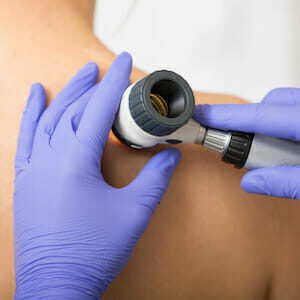Importance of Skin Cancer Screenings
- Posted on: Aug 20 2020
 The Importance of Skin Cancer Screenings: According to the Centers for Disease Control and Prevention (CDC), skin cancer is the most common type of cancer in the United States. With screening exams and early detection, it’s possible to treat and cure skin cancer.
The Importance of Skin Cancer Screenings: According to the Centers for Disease Control and Prevention (CDC), skin cancer is the most common type of cancer in the United States. With screening exams and early detection, it’s possible to treat and cure skin cancer.
If you’re wondering, Where can I get a skin cancer screening near me?, keep reading to find answers to common questions about skin cancer screening exams, including who should receive them, the benefits of screening, and how to exam your skin at home.
What Is a Skin Cancer Screening Exam?
A skin cancer screening exam is used to detect the early signs of skin cancer. It’s a visual exam of the skin by a doctor, which you can also perform at home. During the screening, your skin will be examined for moles, spots, or growths that are unusual in texture, color, shape, or size. Any type of unusual marks could be a sign of skin cancer.
Who Should Receive a Skin Cancer Screening?
According to the Skin Cancer Foundation, adults should receive a full-body, professional skin exam once every year. However, if you have the following risk factors, you may need to receive a skin exam more often.
- Family history or personal history of melanoma or other skin cancers
- History of sunburns
- Frequent use of a tanning bed
- Having a large number of moles
- Fair or light skin tone
- Red hair
- Light-colored eyes (green or blue)
- Skin that burns easily
What Are the Benefits of Skin Cancer Screening?
One of the main benefits of skin cancer screening is recognizing the early signs of cancer before it progresses to an advanced stage. Early detection of skin cancer can save your life, since the condition is highly treatable and curable when caught early. According to the Skin Cancer Foundation, melanoma has a five-year survival rate of 99% when diagnosed early. This is why skin exams are vital.
How Do I Perform a Skin Cancer Self-Exam?
Many doctors and healthcare professionals recommend performing a self-exam for skin cancer about once a month. A good time to conduct the exam is before or after taking a shower or bath. It’s best to perform a skin cancer self-exam in a well-lighted room. To ensure that you can see your whole body, you should use a full-length mirror and a handheld mirror. Consider asking a close family member or partner to help you examine areas that are difficult to see, such as your back or scalp.
Follow these easy steps for carefully examining your skin:
- While standing in front of a full-length mirror, examine your face, ears, neck, chest, and stomach.
- Carefully check your scalp, using both mirrors to get a closer look. Make sure to part your hair to expose each section of your scalp.
- Take a look at your left and right sides with your arms raised.
- Examine your forearms and upper arms. Don’t forget to look at your underarm areas.
- Inspect your hands, including the palms and backs, between the fingers, and under the fingernails.
- With your back turned to the full-length mirror, use your handheld mirror to look at your upper back, shoulders, and back of your neck. Then, examine your lower back, buttocks, and genital area.
- Examine your legs, including the front, back, and sides.
- While sitting down, inspect your feet, including the soles, between your toes, and toenails.
During your exam, you should pay close attention to any moles, brown spots, blemishes, and freckles. Get to know the pattern of these marks and become familiar with their appearance so you know what’s normal for you.
Remember the ABCDE (asymmetry, border, color, diameter, evolving) rule when checking your skin for suspicious moles, brown spots, and other markings. These five letters can help you recognize the early signs of melanoma, the most dangerous form of skin cancer.
Here’s what to look for when performing a skin cancer screening:
Asymmetry: Does the mole have an irregular shape? Imagine drawing a line through the middle of the mole. If the halves aren’t symmetrical, meaning one half doesn’t match the other half, you should have it examined by your doctor.
Border: If the edges of the mole are jagged, irregular, or uneven, it could be a warning sign of melanoma. Healthy moles typically have even borders with smooth edges.
Color: Healthy moles are uniform in color and are usually a single shade of brown. If a mole has more than one color, such as varying shades of tan, brown, red, black, it should be checked by your doctor.
Diameter: Pay close attention to the size of the mole. If the mole is larger than a pea or a pencil eraser, it could be a sign of melanoma.
Evolving: Has the mole or spot recently changed in appearance? Any change in color, shape, or size should be evaluated by your doctor. It’s also important to be aware of any itching, tenderness, or bleeding.
Where Can I Receive a Skin Cancer Screening Near Me?
Now that you know more about the importance of screening exams for skin cancer and how to perform a self-exam at home, you probably want to know, Where can I get a skin cancer screening near me? If you find suspicious moles or spots that aren’t normal, talk to your doctor or make an appointment with a dermatologist for a screening exam.
Posted in: Skin Cancer
